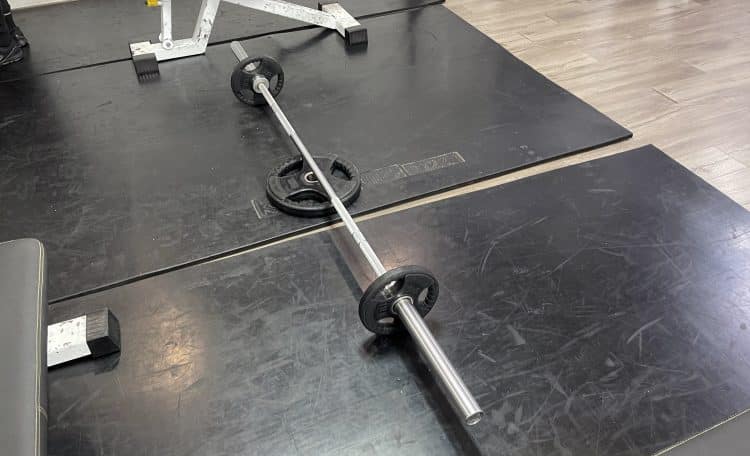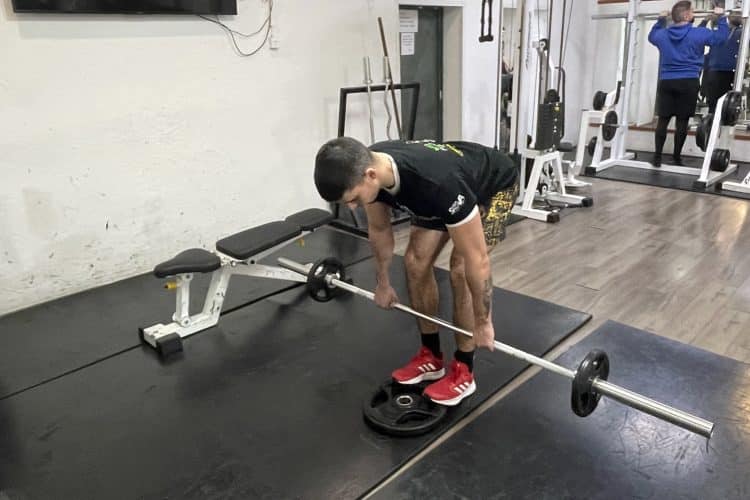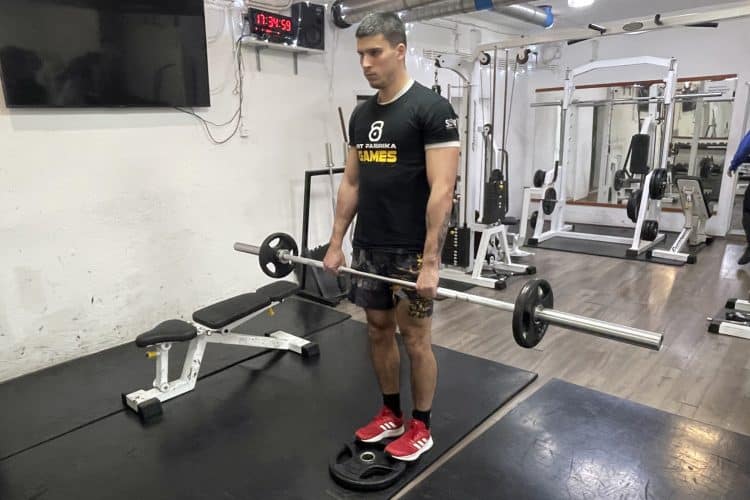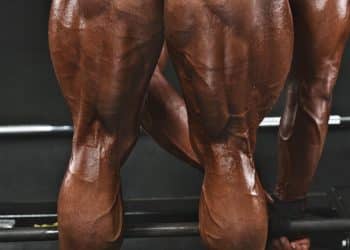Toes elevated Romanian deadlifts (RDLs) are among the most effective lower body posterior chain exercises. I frequently use them in my workouts and with clients as they limit quad activation, allowing you to load the posterior chain muscles better.
It has been proven that posterior chain resistance training (PCRT) is also highly effective at reducing chronic lower back pain (CLBP) and increasing muscular strength.
A meta-analysis published in Sports Medicine-Open concluded, “Clinicians should strongly consider utilizing PCRT interventions for 12–16 weeks with patients with CLBP to maximize their improvements in pain, disability, and muscle strength.” (1)
Also, the study showed no significant difference in the number of adverse events for recreationally active and sedentary patients with CLBP.
In the sections below, I will explain how to perform toe-elevated Romanian deadlifts, and the muscles worked, the most common mistakes, and the best tips. At the end, we will finish with some alternatives to consider in your future workouts.
How To Do a Toes Elevated Romanian Deadlift: Step-By-Step Guide
Here is a quick guide to teach you to perform toes-elevated Romanian deadlifts properly:
Level Up Your Fitness: Join our 💪 strong community in Fitness Volt Newsletter. Get daily inspiration, expert-backed workouts, nutrition tips, the latest in strength sports, and the support you need to reach your goals. Subscribe for free!
Step One — Set Up the Weights
Pick a 45-pound weight plate and place it on the floor. Then, position a loaded barbell above the weight plate.
Pro Tip: Start with a smaller toe elevation (25-pound plate) to learn the proper form and technique of this Romanian deadlift variation. As you gain more experience, you can increase the elevation and weight.
Step Two — Assume the Starting Position
Position the barbell next to your shins and assume a hip-width stance. Position your feet on the weight plate, ensuring that the balls of your feet rest on the plate while your heels are planted on the floor.
While maintaining slight knee flexion, hinge at the hips and grab the barbell with a shoulder-wide overhand grip.
Lift the barbell off the floor by extending your ankles, knees, and hips. Drive your hips forward as the barbell passes over your knees.
Ensure your back is neutral throughout the exercise.
Pro Tip: Keep your core engaged and knees slightly bent throughout the exercise. This helps protect the lower back and ensures that the movement effectively targets the posterior chain muscles.
Step Three — Lower the Barbell Below Your Knees
Lower the barbell toward the floor by hinging at your hips. Push your hips back during eccentrics for optimal muscle stimulation. The barbell should be at shin level at the bottom of the range of motion.
Hold the bottom position for one second before proceeding with the following step.
Pro Tip: Concentrate on hinging at the hips while keeping your knees flexed and stable. The hip hinge is key to isolating and effectively working the hamstrings and glutes.
Step Four — Extend Your Hips
From the bottom position, extend your hips to return to the standing position. Don’t lock out your knees during the isometric contraction.
Pro Tip: Focus on driving through your heels and powerfully extending your hips, thinking about pushing the floor away with your feet. This ensures maximal glute and hamstring engagement. The slight knee flexion prevents excessive joint strain and keeps the tension on your target muscles throughout the movement.
Watch the video guide:
Muscles Worked During Toes Elevated Romanian Deadlifts
Here are the primary muscles worked during the toes-elevated Romanian deadlifts:
- Hamstrings
- Gluteus maximus
Also, here are the secondary muscles:
- Erector spinae
- Adductors
- Forearms
- Core muscles
- Upper back
Tips for Performing Toes Elevated Romanian Deadlifts
Here are the best tips for performing toes elevated Romanian deadlifts:
Elevate Your Toes Properly
Start with a smaller elevation to drill the exercise form and mechanics. This will help you avoid injuries in the beginning. Also, proper exercise form and technique will allow you to execute movement more efficiently.
Beginners should start with a 1-inch elevation and progress by a quarter of an inch every three to four weeks. After you pass two inches, stick to that elevation, as going beyond this can lead to adverse effects.
Level Up Your Fitness: Join our 💪 strong community in Fitness Volt Newsletter. Get daily inspiration, expert-backed workouts, nutrition tips, the latest in strength sports, and the support you need to reach your goals. Subscribe for free!
Start with Lighter Weights
Start with lighter weights to avoid injuring yourself. Starting with an empty barbell is a good starting point if you never performed this exercise before.
Begin adding weights to the exercise only after you can perform it using just the barbell with flawless form.
Maintain a Neutral Spine
Maintaining a neutral spine throughout the entire exercise can lower the risk of serious injuries such as lumbar strains or ruptured discs. You keep your spine neutral by actively contracting your core muscles. Your rectus abdominis, obliques, and transversus abdominis fixate your back during any movement.
I recommend wearing a weightlifting belt while performing compound exercises like the RDLs to lower the risk of injury.
Hinge at the Hips
Romanian deadlifts and their variations must be executed by initiating movement at the hips, not your knees. Hinging from your hips and drive your butt toward the wall behind you.
Keep your knees fixed in the slightly bent position during the entire movement. We want to maximize posterior chain activation while using the quads as stabilizers rather than prime movers or synergists.
Breathe Correctly
Breathing correctly is crucial to maximize exercise performance. Breathe in slowly and deeply during eccentrics. On the contrary, exhale sharply during concentrics.
This will create intraabdominal pressure, which can help keep your spine stable.
Don’t Overextend Your Back at the Top
Avoid leaning back at the top of the range of motion. Keep your hips neutral without overextending them. This significantly reduces lower back injury risk.
Most Common Mistakes During Toes Elevated Romanian Deadlifts
Here are the most common mistakes during toes-elevated Romanian deadlifts:
Improper Toe Elevation
Improper toe elevation initially can alter the exercise movement mechanics and your form, increasing the risk of injuries.
Furthermore, if you elevate your toes too much, it can strain your posterior chain. Elevate your toes as much as you can without altering your form.
Bar Drifting Away From the Body
Keep the loaded barbell close to your body. Try keeping the bar 1 cm from your body throughout the exercise. If the bar drifts away too much from your body, it can place more stress on your lower back, increasing injury risk.
Rounding the Back
Back rounding during exercises often occurs when proper core activation is overlooked. Activate your core muscles, such as rectus abdominis, transversus abdominis, and obliques, to prevent your back from rounding.
Not Keeping Your Knees in a Slightly Bent Position
Maintaining slight knee flexion allows you to load the glutes and hamstrings optimally while performing RDLs. It also helps maintain constant tension on the target muscles, given you don’t fully extend your hips at the top of the ROM.
Progressing Too Quickly with the Weight
Lifting too much too soon can increase injury risk. Also, lifting more weights than you should will hamper your form and technique.
Learn how to employ progressive overload effectively using this guide. (2)
Toes Elevated Romanian Deadlift Variations
Here are some toes elevated Romanian deadlift alternatives:
Toes Elevated Dumbbell Romanian Deadlift
Toes-elevated dumbbell Romanian deadlift is an excellent exercise to develop strong and functional posterior chain muscles. It can help achieve a more significant range of motion than the barbell variation.
Steps:
- Place a weight plate on the floor.
- Pick two dumbbells of appropriate weight.
- Assume a hip-width stance and elevate your toes on the weight plate.
- Start lowering the dumbbells by hinging at your hips and maintaining slight knee flexion.
- Lower until the dumbbells are lower than your knee level.
- Hold the bottom position for one second before proceeding with the following step.
- From the bottom position, extend your hips to return to the standing starting position. Keep your back neutral by activating your core muscles.
- Don’t lock out your knees in the top position, but keep them in the same bent position.
- Repeat for reps
Pro Tip: Ensure the dumbbells move in a straight vertical line close to your body. This maximizes hamstring and glute engagement while maintaining spinal alignment.
Toes Elevated Kettlebell Romanian Deadlift
This exercise is very similar to the dumbbell variation. However, you can grab the kettlebells more freely and bend forward more naturally because of the kettlebells’ design and weight distribution.
Steps:
- Position a weight plate on the floor.
- Pick a kettlebell and hold it with both hands between your legs.
- Assume a hip-width stance and elevate your toes on the plate.
- Start lowering the kettlebell to the floor by hinging at your hips.
- Hold the bottom position for one second before proceeding with the following step.
Pro Tip: Concentrate on keeping your shoulders retracted and chest out. This helps maintain a strong, stable upper back and prevents spine rounding.
Wrapping Up
The toes-elevated Romanian deadlift is among the best exercises to bias the posterior chain muscles. This is because the elevation of your toes leads to increased dorsiflexion, resulting in limited quad activation.
You must implement elevated Romanian deadlifts in your workouts to add diversity and bulletproof your posterior chain. Let me know your thoughts on elevated Romanian deadlifts and how often you perform them in your lower-body workouts.
References
- Tataryn N, Simas V, Catterall T, Furness J, Keogh JWL. Posterior-Chain Resistance Training Compared to General Exercise and Walking Programmes for the Treatment of Chronic Low Back Pain in the General Population: A Systematic Review and Meta-Analysis. Sports Med Open. 2021;7(1):17. Published 2021 Mar 8. doi:10.1186/s40798-021-00306-w
- Peterson MD, Pistilli E, Haff GG, Hoffman EP, Gordon PM. Progression of volume load and muscular adaptation during resistance exercise. Eur J Appl Physiol. 2011;111(6):1063-1071. doi:10.1007/s00421-010-1735-9
Relevant Articles:
Interested in measuring your progress? Check out our strength standards for Dumbbell Romanian Deadlift, Deadlift, Romanian Deadlift.












